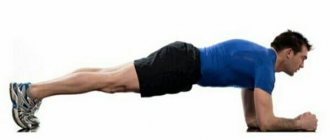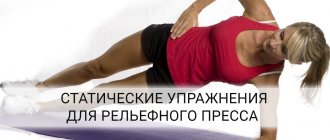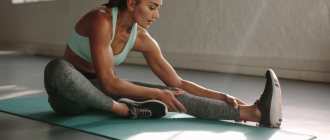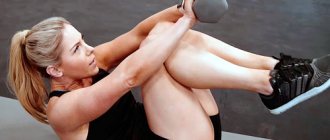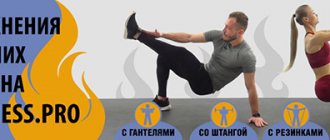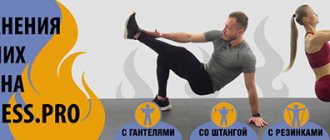Twists or incline crunches are the most common exercise in men's and women's programs. In addition, an inclined abdominal bench is present in any gym. The exercise is quite effective, but it also has its disadvantages and contraindications. It is important that many gym visitors, not realizing their mistakes, perform the exercise incorrectly, which later leads to serious back problems. Let's figure out how to avoid this and how to practice on an inclined bench correctly.
Pros and cons of incline crunches
Benefits and benefits of incline exercises:
- The presence of an inclination allows you to perform the exercise with greater amplitude with constant tension in the abdominal muscles. This increases the load on the abs, compared to crunches on the floor, in which the amplitude is shorter and the muscles relax in the lower position of the body.
- The presence of rollers for fixing the feet allows you to give all your best and load the muscles harder, without thinking about supporting your legs.
- Some types of benches are structurally designed to change the angle of inclination, thereby increasing or decreasing the load. Thus, the bench is suitable for both professionals and beginners.
- The simplicity and dimensions of the design allow you to install the exercise machine at home.
- The bench allows you to perform not only straight, but also oblique twists, more strongly involving the abdominal muscles in the work.
The disadvantage is possible back injury , since the bench does not allow you to determine the lower point of abduction of the body back, thereby inexperienced gym-goers often hyperextend their lower back and lean too far back.
And the main mistake is when lifting and deflecting is performed with a straight back.
All these factors lead to back pain or worsening of existing problems.
Programs
When is the best time to train your abdominal muscles? Are there any special training programs? No! The abdominal muscles are worked out in every workout, regardless of its purpose. During the circuit, twisting is combined with hanging leg raises. This is done to create a deep load on the abdominal cavity. During splits, it is simply physically impossible to stick the abs anywhere, so you train after each complex. But this applies to exercises without weights. In the case of working with weights, it is better to dedicate a separate training day to the abs, doing it completely. This is called a four-day split.
On the last day, the following exercises are highlighted:
- Incline crunches (as one of the variations of abdominal crunches);
- Hanging leg raises;
- Side crunches on the floor;
- Crisscross twists;
- Bike;
- Plank;
- Hyperextension;
- Burpees.
Together, this creates a 40-minute workout, in superset mode, in this case the abs are trained as a counterweight to the back muscles, and hyperextension and planks train the lumbar region, as compensation for the main loads.
What types of crunch benches are there?
- Adjustable – a universal option in which you can set the required inclination angle for crunches or use it as a horizontal bench for bench presses and many other exercises.
- Inclined - these benches are not adjustable and already have a certain preset angle of inclination. This machine can only perform straight or oblique crunches.
- Roman chair - can include the function of a bench for the press, but also makes it possible to perform hyperextension - extension of the torso. Read more about the Roman chair →
- With a curved bench - manufacturers of exercise equipment position the product as safe equipment for back problems, which supposedly allows you to get less stress and get rid of pain in the lumbar region. But this is a very controversial issue, because twisting on a bench does not involve complete lowering, much less hyperextension of the spine, which is completely contraindicated during twisting.
- Folding ones are exercise machines that can be folded, which makes them easy to use at home.
Execution technique
Correct execution of the task will guarantee quick achievement of goals, in our case - high-quality pumping of the press when performing crunches on an incline bench. The technique for performing the exercise in stages is presented below.
- Familiarize yourself with the design of the incline bench. If the machine has a “pin” that adjusts the angle of inclination, then you are in luck. Set the angle to 30 degrees - this is considered the ideal load to start training.
- Sit on the machine, place your legs so that they are securely fixed in the rollers. Remember: the correct position of the legs will allow you to carry out the exercise without unnecessary breaks.
- For comfort, fold your arms across your chest.
- Relax your neck, inhale and lean back. Lie down on a bench or perform the task without touching. The head should not touch the machine.
- Without too much fuss, twist your body, lift your head and shoulders first, and then your whole body. Exhale as you lift your torso. Only the abdominal muscles should work. When a right angle appears between the body and the hips, fix the position (for a second), exhale and lower the torso onto the bench, directing your gaze above your hands.
One set of exercises consists of 10–25 repetitions. Their number depends on the athlete’s level of training. Crunches on an incline bench according to the given technique can be performed before and after training, but not before a general warm-up for the lower abs.
Incline crunch technique
- Place your feet under special bolsters to secure the knee and ankle joints. Your thighs and buttocks should be in full contact with the incline bench.
- Put your hands behind your head or hold them on your chest - this will simplify the load.
- Round your back at the top of the movement and do not straighten your spine until the end of the approach.
- As you inhale, move your torso back, maintaining tension in your abdominal muscles, and lower until the angle between your torso and hips is approximately 90 degrees. Do not lower your back onto the bench, remember the tension in the abdominal muscles and rounding the spine .
- As you exhale, curl your abs, bringing your stomach toward your hips, but do not straighten your back.
How, when and why to pump up the press
Benefits of regularly performing body lifts:
- The stomach becomes flatter, and the abdominal muscles keep the stomach retracted.
- To reduce unwanted stress on the spine and to prevent back pain.
- Increased abdominal muscle strength, which will definitely serve you well in life.
Abdominal sit-ups can be performed at the end of a workout, either alone or in conjunction with other exercises designed to develop the abdominal muscles. Dedicating an entire workout to just the rectus abdominis muscle is impractical. It makes more sense to do 2-3 heavy basic exercises at the beginning of your workout, following the correct technique, and then work on your abs.
How many times should you train your abs?
Opinions vary regarding the number of abdominal workouts per week. So, some people train their abs every day. And some only once a week. To begin with, it is recommended to pay attention to the abs, performing some simple movements with a small number of repetitions, 2-3 times a week. As you gain experience and strengthen your abdominal muscles, you can make the exercises more difficult and also increase the number of repetitions.
The ab workout itself won't take too much time. It is enough to devote about 15 minutes to the press for all exercises. Additionally, you can combine basic movements such as pull-ups and dips with an abdominal workout by simply raising your legs until they are parallel to the floor.
The main thing when performing body lifts is to feel the muscles working and perform each repetition observing the correct technique. The most fundamental classical exercise is the rise of the body.
Oblique crunches on a bench
Crunches are aimed at increasing the contraction of the external oblique abdominal muscles, but this does not mean that the rectus abdominis muscle works less.
- Place your feet under the support cushions.
- Place your hands behind your head and round your back.
- As you inhale, lean back, without straightening your lower back, to approximately a right angle between your hips and torso.
- As you exhale, begin to twist and from the middle of the amplitude, turn your body diagonally, aiming your right elbow towards your left knee, but do not straighten your spine, constantly keep your back rounded .
- As you inhale, in reverse order, slowly lean back to the bottom point of the movement with your torso level.
- Exhale and twist diagonally in the opposite direction.
- And while inhaling, return back to the lowest point. Perform the same number of repetitions on both sides.
Abdominal exercises
Initial position:
- Your back lies on the bench, your lower back is pressed tightly against the bench;
- The legs are bent at the knees (this reduces the load on the lower back), the feet are placed behind the support;
- The elbows are spread to the sides, the hands are behind the head (we do not clasp them in a lock, we do not pull the head forward) or in front of the chest.
Incline sit-ups
- Muscles trained: rectus abdominis.
- We take the starting position. First, the shoulders come off the bench, then the back - and until the torso and legs are at right angles to each other. The back should be slightly rounded. We fix the body in this position for 5 seconds, exhale and, slowly, return to the starting position while inhaling. Concentrate on your abdominal muscles and try to use your legs as little as possible.
Incline sit-ups with reduced amplitude
- Muscles trained: rectus abdominis.
- We take the starting position. We lift the body, but do not return to the starting position - do not lie down completely on the bench. This scheme is suitable for beginners.
Body lifts with rotation
- Muscles trained: obliques, rectus abdominis.
- From the starting position, using the force of the abdominal muscles, we lift our shoulders off the bench and stretch our body towards our legs, slightly turning it to the right and then to the left. Do not try to touch your thighs - in this position the abdominal muscles will relax and the effectiveness of the exercise will decrease. Operation is possible according to the following patterns: left-straight-right, left-straight-right-straight-left, left-right.
Crunches
- Muscles trained: rectus abdominis.
- From the starting position we raise the upper body, then lower it. The lower back and pelvis are not involved in the exercise.
Crunches with rotation
- Muscles trained: obliques, rectus abdominis.
- From the starting position, we raise the torso while simultaneously slightly turning the body to the side (raising the elbow up, pulling it towards the opposite knee). As in the case of lifting the body, work is possible according to the following patterns: left-straight-right, left-straight-right-straight-left, left-right.
Side crunches
- Muscles trained: rectus, transverse and oblique muscles.
- We lie down on the bench sideways: legs on the bench, torso hanging down. Your partner holds your legs and your arms are crossed on your chest. We lower the body to the floor as low as possible, raise it as high as possible. You can also move your body slightly forward or backward.
Twisting from a floor position
- Muscles trained: rectus and oblique muscles.
- The shins lie across the bench on the bench, the body is on the floor, and the hands are behind the head. We twist, raising our torso and touching our knees with our heads. With your head at your knees, exhale strongly, hold at the top point for 2 seconds and return to the starting position.
Bike
- Muscles trained: rectus abdominis.
- We lie with our backs on the bench, with our hands holding the footrest. We raise our straight legs perpendicular to the bench and “pedal.”
Leg Raise
- Muscles trained: rectus abdominis.
- Lie with your back on the bench, your lower back and pelvis pressed tightly against the bench, your legs bent at the knees. We fix our arms above our heads (holding the edge of the bench or footrest). We raise our legs until the pelvis comes off the bench. The exercise can be performed on an inclined bench - head up. This will put more stress on the press.
You can get acquainted with the assortment and, if you wish, buy a bench for the press in our online store. We offer only reliable products from time-tested manufacturers.
Recommendations for Bench Crunches
It's best to do abdominal exercises at the end of your workout. To maximally work your abdominal muscles, perform both variations of crunches on a bench, diluting them with leg raises on a horizontal bench or on the floor. For maximum effect, perform 20-30 repetitions in 3-4 sets.
After getting used to the load, the stronger sex can additionally use weights in the form of a plate, dumbbells or medicine ball. The number of repetitions varies between 15-25, and so on for 3-4 approaches.
Bottom line
Abdominal training is the most important aspect of any athlete's training. Firstly, a well-developed rectus muscle delays the drying process by 5-7 kilograms, which allows you not to torment yourself with diets and weight loss complexes. And most importantly, a beautiful press, worked out by twisting on an incline bench, is always a good figure. Men and women primarily pay attention not to the quality of the deltoids or triceps, but to the abdominal muscles.
Recommendations for implementation
Abdominal exercises have a simple execution technique, although experienced coaches and instructors will suggest a couple of tricks that make the result of the task even higher.
Crunches also have a set of recommendations:
- Hand position. It is not difficult to make the load on the abs more significant; it is enough to change the position of the upper limbs. Place your hands behind your head. Please note that the palms are located near the ears, and are not interlocked at the back of the head. The correct position of the hands when twisting on an inclined bench is visible in the photo.
- Weights. The next way to increase the load on your abs is to add weights. Professional athletes use plates designed for their weight and physical capabilities. The correct choice of weighting material will allow you to carry out the exercise effectively and without undesirable consequences. Trainers do not advise dabbling with heavy weights: it is better to increase the load on your head by picking up a 2 kg weight plate than to pump your abs with 25 kg on your chest.
- Bench position. To safely complete the task, a beginner needs to set the angle of the bench correctly. It should not exceed 45 degrees. After mastering the exercise and using it for several days, the athlete is allowed to increase the load by tilting the bench at an even greater angle.
- Foot action. The lower limbs fix the athlete on the simulator. Their assistance is not required when performing the task on an inclined bench.
- Breath. Proper alternation of inhalations and exhalations increases endurance. Inhale when lowering the body, exhale when lifting.
Take these recommendations into account when attending your next training session in the gym.
